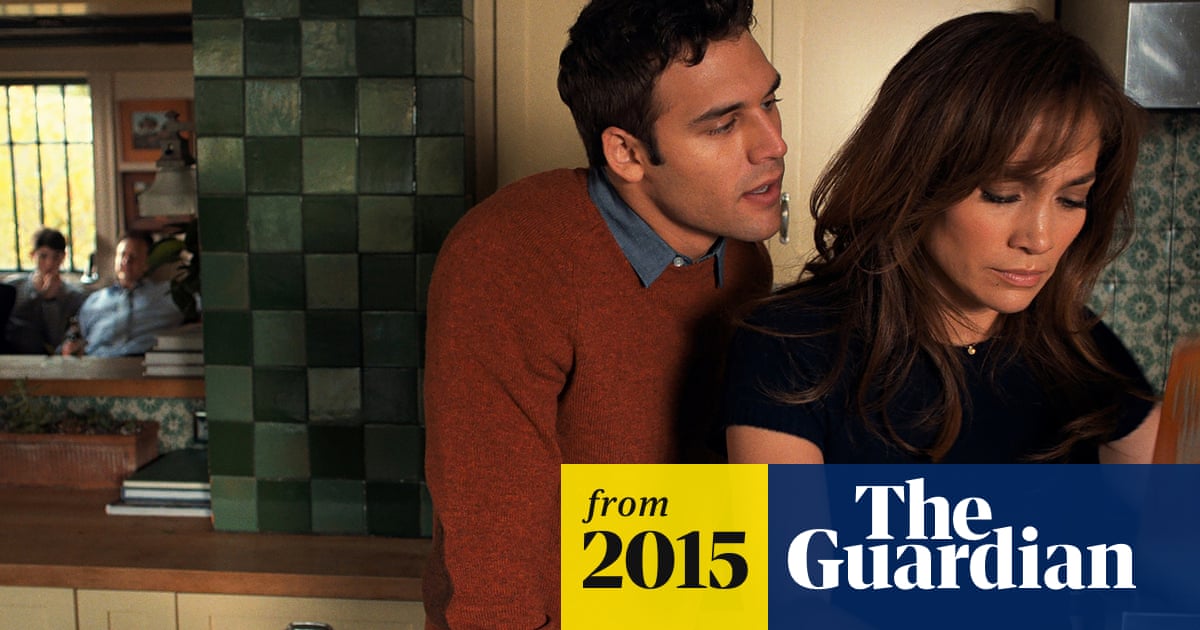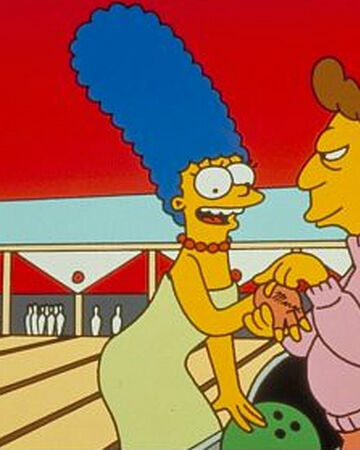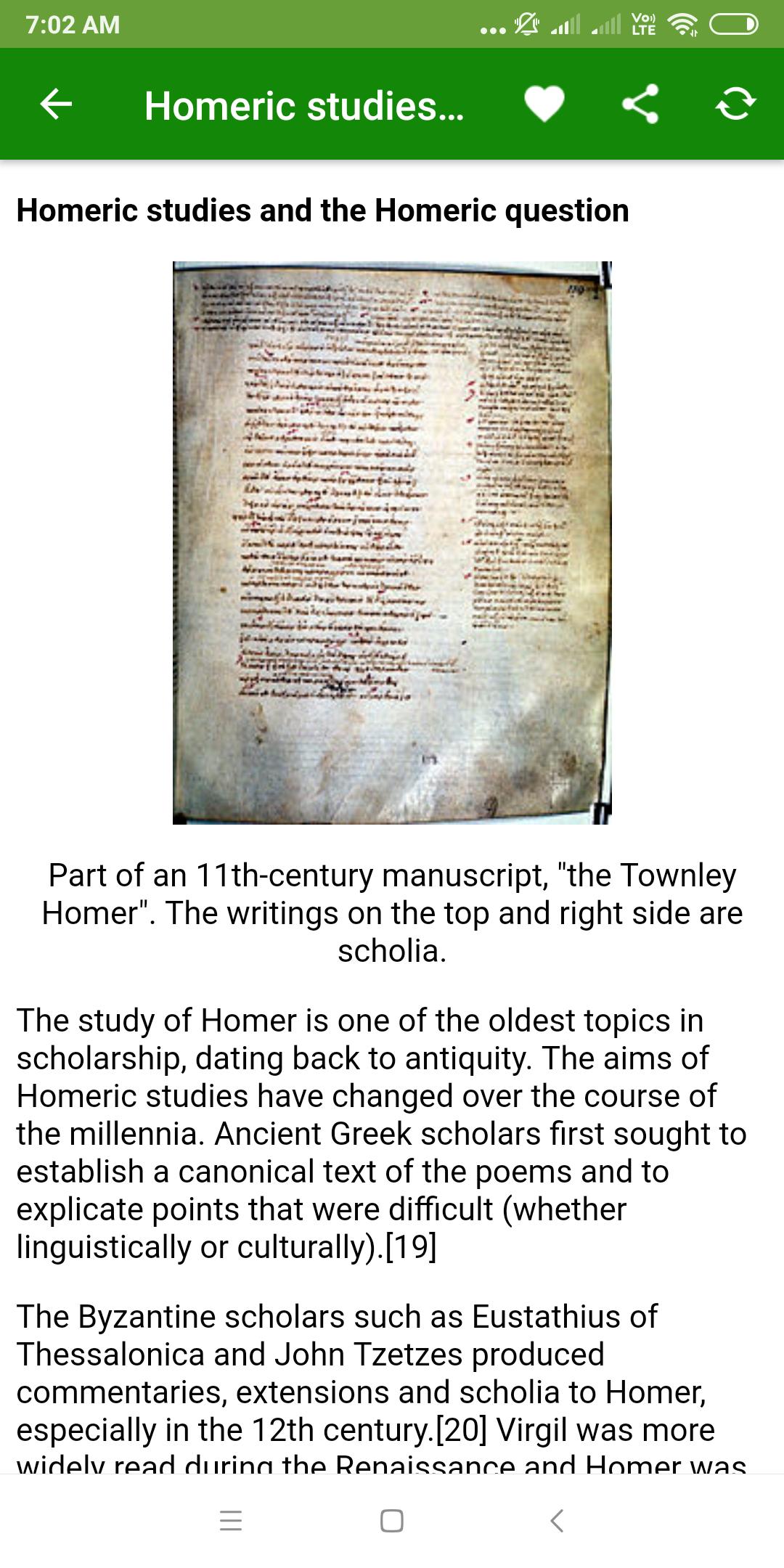February 1, 2008: Homer unintentionally destroys Fast-Food Boulevard, but then later makes up for it when he tells everyone they need to rebuild Fast-Food Boulevard bigger and better than ever. To rebuild it, they need a bond issue that they make part of their next election, the Springfield presidential primary. In 'Homer the Heretic' (season four, 1992), Homer starts skipping church and Marge tells him 'don't make me choose between my man and my God, because you just can't win.' 54 Yet, in some episodes, Marge's stereotypical attitude seems to affect her relationship with her daughter, Lisa, who is a feminist.
Born: Ninth century B.C.E.
Died: Ninth century B.C.E.
Greek poet

H omer, the major figure in ancient Greek literature, has been considered the greatest poet of classical antiquity (ancient times). He wrote both the Iliad and the Odyssey, two epic poems (long narrative poems) surviving in a surprisingly large number of manuscripts.
- Portrait of Homer It is not possible to supply a biography for Homer in the accepted sense of a life history. Since he lived before cultures began recording history, there is no authentic record of who he was, when and where he was born, how long he lived, or even if he was actually responsible for the two epic poems for which he is known.
- Homer fast-forwards over the part with the poem, and Lionel Hutz brazenly dubbed over part of it to try to get a large sum of money (which he says works more often than one would think). Visual Pun: After the funeral, the group leaves with a grandfather clock.
- The site was in a hilly region of southwestern Spain with abandoned mines dating back to the Bronze Age. Nicolson’s title—Why Homer. And knew whether to linger on a scene or fast.
Portrait of Homer
It is not possible to supply a biography for Homer in the accepted sense of a life history. Since he lived before cultures began recording history, there is no authentic record of who he was, when and where he was born, how long he lived, or even if he was actually responsible for the two epic poems for which he is known.
It is arguable that in one incident of the Odyssey the poet may be giving a glimpse of himself in the disguise of a bard (singing poet), whom he calls Demodokos and whom he introduces to the court of the Phaeacian king, where the shipwrecked Odysseus is generously entertained. This Demodokos is described as a 'divine singer to whom the god gave delight of singing whatever his soul prompted him.' He is also described as being blind, which also supports the argument that Homer was portraying himself, because there was a belief that Homer was blind.

Evidence from the epics
This lack of any historical record of Homer's life leaves only what can be taken from the poems themselves. On this task many scholars have attempted to draw conclusions about Homer, often without acceptable results.
The setting of the Iliad is the plain of Troy (an ancient Greek city) and its immediate surroundings. Details of the land are so precise that it is not feasible to suppose that their author created them out of his imagination. To be sure, there is the objection that not all of the poem's action can be made to fit the present-day lands.
In the Odyssey the situation is in many respects quite different. The poet demonstrates that he knew the western Greek island of Ithaca (where the second half of the epic takes place) as well as the poet of the Iliad knew the plain of Troy. The Odyssey, however, also extends over many strange, distant lands, as Odysseus's homeward voyage from Troy to his native Ithaca is transformed into a bizarre sea-wandering adventure.
Perhaps misled by the accuracy with which the Trojan plain is described in the Iliad and the island of Ithaca is pictured in the Odyssey, various modern commentators have tried to impose the same realism on Odysseus's astonishing voyage, selecting actual sites in the western Mediterranean Sea for his adventures. The true situation must be that the Homer of the Odyssey had never visited that part of the ancient world, but he had instead listened to the stories of returning Ionian sailors who explored the western seas during the seventh century B.C.E.
Theory of two authors
That the author of the Iliad was not the same as the author of these fantastic tales in the Odyssey is arguable on several levels. The two epics belong to different literary types: the Iliad is essentially dramatic in its confrontation of opposing warriors who converse like the actors in a tragedy (a play with struggle and disappointment), while the Odyssey is cast as a novel narrated in more everyday human speech. In their physical structure, also, the two epics display an equally obvious difference: the Odyssey is composed in six distinct parts of four chapters ('books') each, whereas the Iliad moves unbrokenly forward in its tightly woven plot.
Readers who examine psychological qualities see in the two works some distinctly different human responses and behavioral attitudes. For example, the Iliad voices admiration for the beauty and speed of horses, while the Odyssey shows no interest in these animals. The Iliad dismisses dogs as mere
Reproduced by permission of
The strongest argument for separating the two poems is the chronology, or dating, of some of the facts in the pieces. In the Iliad the Phoenicians are praised as skilled craftsmen working in metal, and as weavers of elaborate, much-prized garments. In contrast, Greek feelings toward the Phoenicians have undergone a drastic change in the Odyssey. Although they are still regarded as clever craftsmen, the Phoenicians are also described as 'tricksters,' reflecting the invasion of Phoenecian commerce into Greek markets in the seventh century B.C.E.
Oral composition
One thing, however, is certain: both epics were created without writing sources. Between the decline of Mycenaean and the emergence of classical Greek civilizations—which is to say, from the late twelfth to the mid-eighth century B.C.E. —the inhabitants of the Greek lands had not yet acquired from the easternmost shore of the Mediterranean the familiarity with Phoenician alphabetic writing that would lead to classical Greek literacy (and in turn, Etruscan, Roman, and modern European literacy). Therefore it could be concluded that the epics must have been created either before the end of the eighth century B.C.E. or so shortly afterwards that the use of alphabetic writing had not yet been developed sufficiently to record long pieces of writing. It is this illiterate (unable to read or write) environment that explains the absence of all historical record of the author's two great epics.
It is probable that Homer's name was applied to two individuals differing in style and artistic accomplishment, born perhaps as much as a century apart, but practicing the same traditional craft of oral composition and recitation (to read out loud). Although each became known as 'Homer,' it may be (as one ancient source says) that 'homros' was a word for a blind man and so came to be used generically to refer to the old and often sightless wandering reciters of heroic legends. Thus there could have been many Homers.
The two epics Homer is generally regarded as writing, however, have been as highly prized in modern as in ancient times for their vividness of expression, their keenness of personal characterization, and their lasting interest, whether in narration of action or in animated dramatic dialogue.

Other works
Later Greek times credited Homer with the composition of a group of comparatively short 'hymns' (songs of praise) addressed to various gods, of which twenty-three have survived. With a closer look, however, only one or two of these, at most, can be the work of the poet of the two great epics. The epic 'The Battle of the Frogs and Mice' has been preserved but adds nothing to Homer's reputation. Several other epic poems of considerable length— The Cypria, The Little Iliad, The Phocais, The Thebais, and The Capture of Oichalia —were also credited to Homer in classical times.
The simple truth seems to be that the name Homer was not so much that of a single individual but an entire school of poets flourishing on the west coast of Asia Minor (today, the area of Turkey). Unfortunately, we will probably never know for sure, since during this period the art of writing had not been sufficiently developed by the Greeks to permit historical records to be compiled or literary compositions to be written down.
For More Information
Colum, Padraic. The Children's Homer. New York: Macmillan, 1962. Reprint, New York: Collier Books, 1982.
Lorimer, Hilda Lockhart. Homer and the Monuments. London: Macmillan, 1950.
Myres, John L. Homer and His Critics. Edited by Dorothea Gray. London: Routledge & Paul, 1958.
Scott, John Adams. The Unity of Homer. Berkeley: University of California Press, 1921.
Homer Fast Dating Site
| 'I Married Marge' | |||
|---|---|---|---|
| The Simpsons episode | |||
Homer leaves Marge to look for a job. Marge was designed with shorter hair to make her look younger. The characters' pupils were larger than normal in the episode and the eyeballs were unusually round and big.[1] | |||
| Episode no. | Season 3 Episode 12 | ||
| Directed by | Jeffrey Lynch | ||
| Written by | Jeff Martin | ||
| Production code | 8F10 | ||
| Original air date | December 26, 1991 | ||
| Episode features | |||
| Chalkboard gag | 'I will not torment the emotionally frail'. | ||
| Couch gag | The family (except Maggie) cartwheel into place and strikes a pose. Maggie hops onto the couch and joins them, striking the same pose. | ||
| Commentary | Matt Groening James L. Brooks Al Jean Mike Reiss Dan Castellaneta Jeff Martin Jeffrey Lynch | ||
| Episode chronology | |||
| |||
| The Simpsons (season 3) | |||
| List of The Simpsons episodes | |||
'I Married Marge' is the twelfth episode of The Simpsons' third season. It originally aired on the Fox network in the United States on December 26, 1991. In the episode, Marge worries that she may be pregnant again and visits Dr. Hibbert's office. While anxiously waiting at home, Homer tells Bart, Lisa, and Maggie the story of his and Marge's marriage and Bart's birth. The episode was written by Jeff Martin and directed by Jeffrey Lynch.
'I Married Marge' was the second flashback episode of The Simpsons after season two's 'The Way We Was'. It features cultural references to The Empire Strikes Back, Charlie's Angels, and Ms. Pac-Man. The title of the episode is a play on the American television series I Married Joan. Since airing, 'I Married Marge' has received mostly positive reviews from television critics. It acquired a Nielsen rating of 11.9 and was the highest-rated show on Fox the week it aired.
The episode was the first of three about the births of the Simpsons children, this one covering Bart's birth, with Lisa's covered in 'Lisa's First Word' in the fourth season, and Maggie's covered in the sixth-season episode 'And Maggie Makes Three'. The episode also expands upon the family's origins as a result of Marge falling pregnant with Bart, briefly referred to in 'The Way We Was', and introduces key moments, such as Bart's conception at a Mini-Golf course, which would ultimately become a major part of the series' canon.
Plot[edit]
Marge worries she may be pregnant again after a home pregnancy test is inconclusive, so she drives to Dr. Hibbert's office to take another test. While she is gone, Homer tells Bart, Lisa and Maggie the story of their marriage and Bart's birth.
In 1980, Homer worked at a mini-golf course while dating Marge. Marge's mother Jacqueline and twin sisters Patty and Selma disapproved of Homer's lack of prospects and unattractive physical appearance. One night, Marge and Homer saw The Empire Strikes Back (whose twist ending Homer inadvertently ruined for the next audience) and made out inside a golf course castle. In August 1981, Marge felt sick and told Homer she might be pregnant. Homer was not thrilled when Dr. Hibbert confirmed this. Since he loved Marge, he proposed marriage to her and she accepted.
They married in a seedy wedding chapel across the state line and spent their wedding night on the living room couch at Marge's family's house. Homer's wages from the golf course were insufficient to support his growing family, so he applied for a job at the Springfield Nuclear Power Plant. He was rejected because Smithers favored two other applicants who happened to be his old college fraternity brothers. In 1982, when Homer and Marge's newly purchased baby supplies and Marge's wedding ring were repossessed, Homer left to find steady work, hoping to return once able to support his family. Marge was devastated when she read his farewell note.
Patty and Selma spotted Homer working at a Gulp 'n' Blow fast food restaurant. Seeing how unhappy Marge was without him, Selma reluctantly told her where to find him. Marge tried to persuade Homer to come home with her.

Homer applied for a job at the power plant again, telling Mr. Burns he would be the perfect employee due to his unwavering subservience. Burns was so impressed that he hired Homer on the spot. Homer returned home to learn Marge was in labor at the hospital. He found Marge with Selma and an angry Patty, who berated him. Fed up with her disrespect, Homer angrily told Patty and her family to show him some respect since he now had a well-paying job – news which delighted Marge right before she gave birth to Bart. Upon meeting him, Bart sets fire to Homer's tie. Homer accuses him of doing it on purpose, to which Marge says that he could not have because he is only ten minutes old.

After Homer ends his flashback, he tells Bart, Lisa and Maggie he is blessed to have such children. Marge arrives home with the news that she is not pregnant and high-fives Homer.
Production[edit]
'I Married Marge' was written by Jeff Martin and directed by Jeffrey Lynch. It was the second flashback episode of The Simpsons and a sequel to the previous one, 'The Way We Was', which tells the story of how Homer and Marge met in high school.[2] Executive producer Sam Simon was concerned that the writers were being 'inefficient' with the episode; he thought the three plots of Homer and Marge's marriage, the birth of Bart, and Homer getting his job should have been extended into three episodes instead of one.[3]
The staff were concerned over the animation of the characters' eyes in the episode, as the pupils were larger than normal, making the characters look 'stoned', and the eyeballs were 'too round' and large. The animation artists at the animation studio in South Korea, where much of the animation process takes place, had begun stenciling the eyes with a template, which according to Lynch resulted in 'strangely round eyes which look a little too big sometimes and much too perfect. Which is very un-Simpsons like.'[1] Marge was designed with shorter hair in the flashback sequences to make her appear younger. Lynch thought it was nice to see Marge in a 'younger, more attractive mode, and sort of watching her progress through pregnancy.'[1]
Cultural references[edit]
The title of the episode is a reference to the American television series I Married Joan.[4] Marge and Homer sing along to 'You Light Up My Life' by Debby Boone in the car. When Marge is suspected to be pregnant, Bart wants to name the baby after rapper Kool Moe Dee, while Lisa wants to name her after Ariel, from The Little Mermaid.[2] At the beginning of his story, Homer mentions the band Supertramp, and their popularity in the time period.[5] While exiting the movie theater, Homer spoils the ending of The Empire Strikes Back for dozens of moviegoers awaiting the next show. He also compares Marge's good looks to Princess Leia and her intelligence to Yoda, two characters from the film.[6][7]
Homer's encounter with the doughnut delivery man is a reference to a scene in the film Willy Wonka & the Chocolate Factory.[4] Homer and his best friend Barney Gumble are watching Charlie's Angels when Marge tells the news of her pregnancy.[4] A poster of Farrah Fawcett, a cast member of Charlie's Angels, hangs on the wall in Barney's apartment.[2]Dolly Parton's 9to5 is heard when Homer looks for a new job. The sign outside the wedding chapel resembles Vegas Vic from the Pioneer Club in Las Vegas.[2] When Homer returns to the power plant to apply for a job the second time, Mr. Burns is seen playing the arcade game Ms. Pac-Man.[8] The episode marks the first appearance of Burns's assistant Smithers's first name, Waylon, which comes from the puppeteer Wayland Flowers.[8] When Homer is working at the Gulp N' Blow, he is wearing an 'I Shot J.R.' T-Shirt, a reference to the Who Shot J.R.? storyline in Dallas in 1980, which would later provide inspiration for the two-part 'Who Shot Mr. Burns?' episode in 1995.[4]
Reception[edit]
In its original American broadcast on December 26, 1991, 'I Married Marge' finished 27th in the ratings for the week of December 23–29, 1991, with a Nielsen rating of 11.9, equivalent to approximately 11 million viewing households. It was the highest-rated show on Fox that week.[9] Marge's voice actor, Julie Kavner, received a Primetime Emmy Award for Outstanding Voice-Over Performance in 1992 for her performance in the episode.[10][11]
Since airing, the episode has received very positive reviews from television critics. Pete Oliva of North Texas Daily praised the writers for providing back stories that are 'believable' and do not feel 'contrived or hastily thought through'.[12] The authors of the book I Can't Believe It's a Bigger and Better Updated Unofficial Simpsons Guide, Warren Martyn and Adrian Wood, thought it was a 'moving' episode with 'plenty of great setpieces'.[4]
DVD Movie Guide's Colin Jacobson described the episode as 'sweet and funny' and a 'nice piece of Simpsons history'. Jacobson went on to say he enjoyed the flashback concept and that the episode develops the characters 'nicely' and gives the viewers 'a good sense for the era in which it takes place'.[13] Nate Meyers of Digitally Obsessed rated it a5 (of 5), and highlighted the scenes with Marge's sisters Patty and Selma, 'barraging Homer with insults', as the 'funniest moments' of the episode. Meyers added: 'The episode's climax is a great moment for Homer and fans of the show.'[14] Molly Griffin of The Observer said 'I Married Marge' is one of the season three episodes that turned the show into 'the cultural force it is today'.[15]
In his book Drawn to Television – Prime-time Animation from the Flintstones to Family Guy, Keith Booker wrote: 'The episode details in a rather sentimental fashion the early struggles of the irresponsible Homer to support his new family [...] Such background episodes add an extra dimension to the portrayal of the animated Simpson family, making them seem oddly real and adding weight to their status as a family with a long history together.'[16]
References[edit]
- ^ abcLynch, Jeffrey (2003). The Simpsons season 3 DVD commentary for the episode 'I Married Marge' (DVD). 20th Century Fox.
- ^ abcdJean, Al (2003). The Simpsons season 3 DVD commentary for the episode 'I Married Marge' (DVD). 20th Century Fox.
- ^Martin, Jeff (2003). The Simpsons season 3 DVD commentary for the episode 'I Married Marge' (DVD). 20th Century Fox.
- ^ abcdeMartyn, Warren; Wood, Adrian (2000). 'I Married Marge'. BBC. Retrieved 2009-06-07.
- ^Groening, Matt (1997). Richmond, Ray; Coffman, Antonia (eds.). The Simpsons: A Complete Guide to Our Favorite Family (1st ed.). New York: HarperPerennial. p. 74. ISBN978-0-06-095252-5. LCCN98141857. OCLC37796735. OL433519M.
- ^Groening, Matt (2003). The Simpsons season 3 DVD commentary for the episode 'I Married Marge' (DVD). 20th Century Fox.
- ^Chernoff, Scott (2007-07-24). 'I Bent My Wookiee! Celebrating the Star Wars/Simpsons Connection'. Star Wars.com. Archived from the original on July 24, 2011. Retrieved 2011-08-28.
- ^ abReiss, Mike (2003). The Simpsons season 3 DVD commentary for the episode ' I Married Marge' (DVD). 20th Century Fox.
- ^'Nielsen Ratings /Dec. 23-29'. Long Beach Press-Telegram. January 1, 1992. p. D5.
- ^'Primetime Emmy Awards Advanced Search'. Emmys.org. Archived from the original on July 15, 2009. Retrieved 2009-02-05.
- ^'Briefing–'Simpsons' score big in Prime-Time Emmys'. Daily News of Los Angeles. August 3, 1992. p. L20.
- ^Olivia, Pete (August 29, 2003). 'Simpsons' third box set charming, feature-filled'. North Texas Daily. Retrieved 2009-07-02.[permanent dead link]
- ^Jacobson, Colin (August 21, 2003). 'The Simpsons: The Complete Third Season (1991)'. DVD Movie Guide. Retrieved 2009-06-06.
- ^Meyers, Nate (June 23, 2004). 'The Simpsons: The Complete Third Season'. Digitally Obsessed. Retrieved 2009-06-06.
- ^Griffin, Molly (January 21, 2004). ''Simpsons' DVD set delivers the goods'. The Observer. Archived from the original on August 10, 2011. Retrieved 2009-07-03.
- ^Booker, Keith (2006). Drawn to Television - Prime-time Animation from the Flintstones to Family Guy. Greenwood Publishing Group. p. 52. ISBN978-0-313-07615-2.
External links[edit]
Homer Fast Dating Games
| Wikiquote has quotations related to: I Married Marge |
Homer Fast Dating Sites
- 'I Married Marge' at The Simpsons.com
- 'I Married Marge episode capsule'. The Simpsons Archive.
- 'I Married Marge' at IMDb
- 'I Married Marge' at TV.com
Comments are closed.